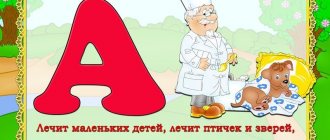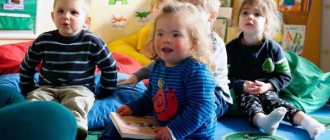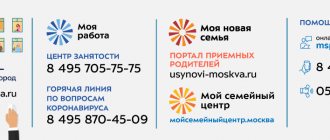MAGAZINE Preschooler.RF
“Organization of the work of a speech therapist in the context of the introduction of the Federal State Educational Standard for Educational Education”Prepared by: teacher-speech therapist of the highest qualification category Svetlana Viktorovna Shumova, Municipal preschool educational institution “Combined kindergarten No. 1”
Changes have occurred in the preschool education system in recent years: a new “Law on Education in the Russian Federation” and Federal State Educational Standards for Preschool Education have been adopted. For the first time in the history of our country, preschool education became the first level of education.
The new requirements that the legislation puts into understanding the work of a speech therapist at the present stage are to rebuild their activities with knowledge of new technologies, new rules, and new approaches to organizing their own work.
Speaking about the work of a speech therapist within the framework of the federal state standard, I would like to dwell on those documents that regulate the work of a speech therapist.
In our work we are guided primarily by:
- Law of the Russian Federation “On Education” No. 273 F3
- Federal Law “On Special Education of Persons with Disabilities”
- “Model regulations on a preschool educational institution”
- Order of the Ministry of Education and Science of Russia dated October 17, 2013 N 1155 “On approval of the federal state educational standard for preschool education .
These are the main documents regulating the activities of both correctional teachers in general and speech therapists in particular. They relate to the field of general education, and standards, federal and state requirements that would directly relate to correctional education do not currently exist. There are only draft laws, public hearings and public discussions of the draft concept of the Federal State Educational Standard for students with disabilities are taking place. This standard was developed by specialists from the Institute of Correctional Pedagogy and KP RAO in Moscow. This standard has been discussed, but so far this standard has not been accepted, because the issue of integration, the question of where children with developmental problems, in particular children with speech problems, should be widely discussed, are now being widely discussed. pathology, intellectual disability. The issue is being resolved, and this project is supported by the government. Everyone is inclined to believe that inclusion is inclusion, but there are categories of children who cannot be taught in any way in the general education school system, in particular, the category of children with intellectual disabilities. Currently, the system of correctional education and defectology is preserved and this standard, discussed, adjusted, and not yet adopted, is freely available on the ICPRAO website.
A feature of the Federal State Educational Standards project for primary general education for children with speech impairments is that the decision to choose an educational route is given not to the general program, but to a specific specialist who will work with the child and depends on the requests of the parents, on an objective picture of the child’s physical and mental status. The more complex the structure of the defect, the more the program becomes variable, the greater the proportion of life competence, i.e. formation of vital skills. Minimum programs for children with speech pathology. For preschoolers, these are T.B. programs. Filicheva, G.V. Chirkina, G.A. Porridge. For schoolchildren, for children with dysgraphia, with dyslexia there is no such thing. Only the recommended options are for practicing speech therapists, who in each specific case build their work in relation to the strategy of correctional and speech therapy work with the contingent of children who came to them at the educational institution.
Paragraph 2.6 of the Federal State Educational Standard defines the directions of development and education of children (educational areas):
- social and communicative development
- cognitive development
- speech development
- artistic and aesthetic development
- physical development.
I would like to dwell on “speech development”. Although this area is separated into a separate one, we can find interdisciplinary connections in the implementation of all these areas. For example: physical development includes motor development, development of general motor skills. Where there is no general motor skills when correcting phonetic disorders in dysarthria in children, where there is general motor skills, there is fine motor skills, there is articulation, where there is speech therapy, there is physical education. If we are talking about artistic and aesthetic development, then it is understood that children are developing musical abilities, if these are musical abilities, then this is the work of a music director, and if this is the work of a music director and speech therapist, then this is a lesson in logorhythmics; without logorhythmics, classes with children with stuttering.
Speech development includes:
- mastery of speech as a means of communication
- enrichment of the active dictionary
- development of coherent speech, grammatically correct dialogical and monologue speech, development of speech creativity
- development of sound and intonation culture of speech, phonemic hearing
- acquaintance with book culture, children's literature, something that we do not deprive of attention in the structure of a speech therapy lesson when we say that any lesson should be built within the framework of one lexical topic, united by a common game plot.
- listening comprehension of texts from various genres of children's literature. This is a hint at the development of impressive speech, at the understanding of spoken speech, including that implemented in children's literature, in written and speech creativity.
- the formation of sound analytical-synthetic activity as a prerequisite for learning to read and write (prevention of dysgraphia, dyslexia, written language disorders in general. Fully taken into account in this section, in this direction in the structure of the educational program of a preschool educational institution.
In this area, all the areas of work that we, speech therapists, work with are defined.
The content of the work will depend on who we work with, on the age and individual characteristics of the children, and is determined by the goals and objectives of the program. It will be reflected in the general education program and the partial speech therapist program. It can be implemented in communication, in play, in cognitive and research activities. This provides an opportunity for creativity, i.e. this can be done in any type of activity in a group, office, or in the structure of classes of other specialists. But no one forbids conducting traditional speech therapy classes, which will later turn into a class-lesson system at school. Seatedly sitting at the table, and not lying on the floor, in front of a mirror and in the structure of traditional communication, teacher-student, child with speech pathology - speech therapist, child-adult. Both in group, subgroup and individual forms of work.
The main idea of the Federal State Educational Standard for Education is to support the diversity of childhood by creating conditions for the development of the abilities of each child. Each child will develop at the pace that is characteristic of him. Modern children are different from us, therefore, it is increasingly difficult to establish interaction between a child and a parent, a child with a teacher, a child with society.
Unfortunately, at present, a generation of children is growing, often indifferent to speech activity, demonstrating a dislike for difficult tasks, avoiding regular efforts and difficulties in general. Speech communication for such children is not personally significant.
There is also a “fading” of parental initiative - another pressing problem of today. That is why the search and introduction into practice of new forms of work with preschoolers and their parents is so important.
Children with speech disorders are often mentally unstable; they have an unstable psycho-emotional state, decreased performance and fatigue. Speech therapy classes for such children are hard work. It’s nice when children go to classes with a speech therapist with joy and desire, in anticipation of what awaits them today. What can await them? An attractive environment in the workspace of the speech therapist teacher, aesthetic design, game teaching aids, this is the only way to interest the child and invite him to dialogue.
In these changing conditions, we preschool teachers need to be able not only to freely navigate a wide range of modern technologies, but also to effectively implement them.
In accordance with the Federal State Educational Standard, the educational process must be based on age-appropriate forms of working with children.
It is possible to involve a child in activities only when he is interested, when he is passionate and plays. What is the main form of work with preschool children and the leading type of activity? Of course it's a game. If play is the main activity for a child, it means that we, as teachers, need to switch to play, what kind of game? A game that was built on the initiative of children, that is, an exciting, meaningful game. To achieve this, I tried to create a content-rich environment for the implementation of productive, exciting, educational and creative joint activities with children.
Currently, the interest of teachers (speech therapists, educational psychologists, educators) in the use of sand games in working with children has increased significantly.
Light tables for sand painting have become especially popular now. It's not really a game though. Working with sand develops tactile sensations and hand motor skills.
Sand drawing is ideal for activities with hyperactive and overly excitable children. The sand therapy method is especially suitable for children who, for whatever reason, refuse to complete various tasks in traditional classes.
The natural need of children to play with sand gave me the idea to use a sandbox in my work. Partial transfer of speech therapy classes to the sandbox provides a greater educational and educational effect than standard forms of training.
Firstly, the child’s desire to learn something new, experiment and work independently increases significantly.
Secondly, when playing with sand, tactile sensitivity develops as the basis of “manual intelligence” .
Thirdly, in games with sand, all cognitive functions (perception, attention, memory, thinking), as well as speech and motor skills, develop more harmoniously and intensively.
Fourthly, object-based play activities are improved, which contributes to the development of role-playing games and the child’s communication skills.
Along with this, it is known that sand absorbs negative mental energy and has a relaxing effect.
This is how a box of sand appeared in my speech therapy office. For games and activities in the sandbox - a lot of figures no more than 8 cm high on different lexical topics. These are people, animals, vehicles, marine life, etc. toys from Kinder Surprises . Also various natural materials (sticks, fruits, seeds, shells, etc.).
A tablet for drawing with sand with backlight (they write syllables, draw (without light), make up a story based on the actual picture they drew, draw vegetables, fruits, trees.
I add details to the sand box, and we get “Color Parallels” -
I add mystery to the situation, asking the question: “How can you find out what is hidden under the sand without touching it?” . At the same time, I offer children various objects as a hint: a stick, a tube, a stone, a string, etc. I give you a plan diagram in which, using symbols, it is indicated where the objects are located. The guys agree on who reads the diagram (for example, the first object is in the yellow row, in the second cell from the top, etc.), and who finds the objects using a brush. Next, the pairs determine and pronounce where the sound is hidden. Objects are placed in different sections of the sand table: objects with sounds at the beginning of the word are placed in the right, and at the end of the word in the left. At the same time, spatial concepts are developing, thereby increasing the effectiveness and quality of activities (productive, creative, cognitive).
With the help of “Merry Men” , which are a latex ball filled with sand, thanks to which it can take different shapes.
I give the children a task: when they hear the sound “C” , make a smile, when there is no sound - sadness (the corners of the lips are lowered). So, with the help of facial expressions, they convey the emotions of “little people” and at the same time develop auditory memory.
I teach students the skill of syllable synthesis. I display the “little men” in pairs (the first blue one next to the red one with the symbol for the sound “A” , in the form of a mouth - a large circle). The child connects the sounds and receives the syllable “SA” . Similar work is carried out with other vowel sounds.
I use play exercises with sand in individual speech therapy work with children, as well as as an element of a subgroup lesson.
Experience shows that the use of sand therapy allows even “complex” child to open up, maintain the preschooler’s ability to work longer, and also increase interest in speech therapy classes.
Along with this, it is known that sand absorbs negative mental energy and has a relaxing effect.
One of the non-traditional speech therapy technologies is Su-Jok therapy (“Su” – hand, “Jock” – foot)
The famous teacher V.A. Sukhomlinsky once said that a child’s mind is at his fingertips. And these are not just nice words. The thing is that in the human brain the centers responsible for speech and finger movements are located very close. By developing fine motor skills, we activate neighboring areas of the brain responsible for speech. And the formation of speech contributes to the development of thinking.
In correctional and speech therapy work, Su-Jock therapy techniques can be used as a massage for dysarthric disorders, for the development of fine motor skills of the fingers.
Massage with a special ball. Since there are many biologically active points in the palm of your hand, an effective way to stimulate them is to massage them with a special ball. By rolling the ball between their palms, children massage their arm muscles. (Stroke my palms, hedgehog! You’re prickly, so what! I want to stroke you, I want to get along with you).
Each ball has “magic” ring.
We put the rings on the fingers one by one and massage them (finger game “boy-finger” - Boy-finger, Where have you been? I went to the forest with this brother, cooked cabbage soup with this brother, ate porridge with this brother, sang songs with this brother) .
Absolutely safe - incorrect use never causes harm - it is simply ineffective.
In my work I also use I. Lykova and I. Maltseva’s “Logical Baby” tablets with sets of cards with exercises for children to master primary literacy.
I widely use ready-made picture-graphic diagrams and plans for stories by Bardysheva T. Yu., Monosova E. N.
The authors note that the most effective methods and technologies for the development of coherent speech are those based on building a coherent statement with the help of visual images (object pictures, stimulus symbols, from which a sentence diagram and a story plan are made up. Coherent speech in this case is formed using pictures -graphic diagrams. Thanks to this technique, children will be able to adequately use various types of sentences, retell texts and compose stories based on picture-graphic plans independently.
“Teach a child some five words unknown to him - he will suffer for a long time and in vain, but associate twenty such words with pictures, and he will learn them on the fly . (K. D. Ushinsky).
Recently in my work I began to use such a form of work as a laptop. I decided to design games and speech material on sound reinforcement in the form of a laptop that is now fashionable. A laptop is a homemade book - a folding bed or a thematic folder with different pockets and moving parts. It collects material on a specific topic. At the same time, a finished lapbook is not just a craft. This is the final stage of sound work that the child has done on the topic. At each stage of work on consolidating sound, according to my instructions, children, together with their parents, make pockets for games, select games, riddles, tongue twisters, pictures and other materials for games. The lapbook “Visiting Shipelochka” presents games and exercises aimed not only at automating the sound [sh], but also tasks for the development of phonemic awareness, sound analysis and synthesis, the prosodic side of speech, and grammar. All work with a laptop contributes to the enrichment of vocabulary, the development of thinking, visual perception, memory, attention, and fine motor skills.
We live in the information age. Computerization has penetrated almost all spheres of life and activity of modern man. Therefore, the introduction of computer technology in education is a logical and necessary step in the development of the modern information world as a whole. In accordance with the Concept of introducing new information technologies into preschool education, the computer should become the core of the developmental subject environment in kindergarten. Therefore, it is important to create a system of work using a computer for the development of a child and, above all, the formation of his psychological readiness for life and activity in a society that widely uses information technology. For a preschool child, play is the leading activity in which his personality is manifested, formed and developed. And here the computer has ample opportunities, because correctly selected educational computer games and tasks are, first of all, a gaming activity for a child, and then an educational one. Children receive an emotional and cognitive charge that makes them want to consider, act, play, and return to this activity again. This interest underlies the formation of such important structures as cognitive motivation, voluntary memory and attention, and the prerequisites for the development of logical thinking.
Special computer games “Learning to speak correctly” , “Games for tigers”, etc. “Speech games” for the interactive whiteboard.
Recognizing that the computer is a new powerful tool for the intellectual and creative development of children, it is necessary to remember that it should only complement the teacher, and not replace him.
As a speech therapist teacher, I use ICT in my work to:
- Selection of illustrative material for classes and for the design of stands, groups, offices (scanning, Internet, printer, presentation).
- Selection of additional educational material for classes, familiarization with event scenarios.
- Getting acquainted with periodicals and the work of other teachers.
- Preparation of group documentation and reports. The computer will allow you not to write reports and analyzes every time, but rather just type the diagram once and then only make the necessary changes.
- Creating presentations in the Power Point program to improve the effectiveness of educational activities with children and the pedagogical competence of parents in the process of holding parent meetings, master classes, and “Round tables” .
- Exchange of experience: creating your own mini-sites on popular portals, publishing materials on teaching activities on various sites.
In my practice, I actively use Internet resources as the main source of self-education. In order to meet the standard of a modern specialist, she registered mini-sites on well-known portals on the Internet.
In practical activities, I use presentations for children and their parents, colleagues as part of open events (classes, joint project activities with preschool teachers).
The preschool education standard places special demands on the activities of a speech therapist teacher. A modern speech therapist is obliged to bring a positive mood when communicating with children, parents, and colleagues, which allows them to establish communication connections and resist stressful situations.
And the innovative technologies that I use in my own speech therapy practice are based on the priority areas of the Federal State Educational Standard for Educational Education.
| Next > |
Main aspects of the application of professional standards
The procedure for the development and application of professional standards is determined by the following acts:
- Adopted in 2015, 122-FZ, which lists the main provisions for their use.
- Articles 195.2 and 195.3 were introduced into the Labor Code on the basis of this Federal Law, which established the mandatory use of professional standards for professions whose qualification parameters are given in the current legislation.
- Government Resolution No. 584 adopted in 2021, which states that professional standards are mandatory for budgetary institutions, as well as organizations that are 50% or more controlled by the state.
As can be seen, in the private sector, the application of professional standards occurs on a voluntary basis. In the business sphere they are used for:
- Documenting qualification parameters (education, work experience, specialized and general skills). This allows not only to correctly screen out applicants with inappropriate qualifications, but also to require employees to undergo additional training.
- Changes in the organizational structure, which are carried out by renaming positions, changes in staffing, and eliminating non-core responsibilities.
- Resolving disputes with representatives of regulatory authorities (Federal Tax Service, Rostrud, etc.) during their inspections of documentation.
- Introducing current changes to the organization’s documents regulating personnel relations: job descriptions, employment contracts, etc.
Attention! So far, in the field of personnel relations, all-Russian directories of professions (EKS and ETKS) remain relevant. In the future, it is planned to integrate them into a unified system of labor documentation, but for now the employer can use them along with professional standards.
Application of the professional standard in practice
The introduction of professional standards into office work practice is based on a certain algorithm:
- Studying the industry characteristics of the employer’s activities using OKVED codes.
- Analysis of available positions and the range of responsibilities performed by current specialists. This analysis is based on the staffing table, job descriptions and other personnel documentation.
- Studying existing professional standards that suit the profile of the organization and its employees.
- Changing labor documentation based on the provisions of the found professional standards, as well as relevant sections of the EKS and ETKS.
- Carrying out the necessary changes in the organizational structure of the organization (redistribution of responsibilities, introduction of new positions, etc.).
After completing a set of these measures, based on the changes made, the employer receives the opportunity to:
- Present qualified requirements to candidates for positions.
- Oblige existing employees to improve their professional level to acquire the necessary skills and abilities.
- Offer low-skilled employees to move to less significant positions using Article 72.1 of the Labor Code of the Russian Federation.
Attention! If the organization employs many employees in various positions, then it is recommended that the implementation of professional standards be carried out on the basis of regulations that establish responsible persons, the procedure for implementation, deadlines and other parameters.





